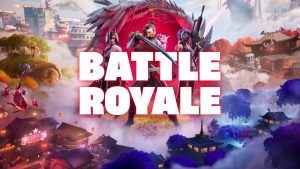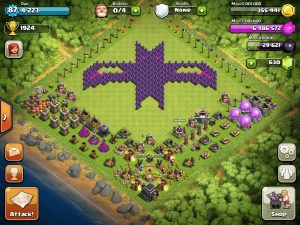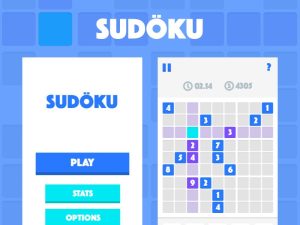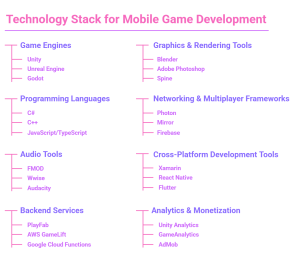This list dives into the most compelling game development ideas for 2025, featuring innovative gameplay twists, smart monetization strategies, and concepts that give players exactly what they’re craving. Whether you’re looking to reinvent genres or create something entirely fresh, these 60 video game development ideas are here to inspire your imagination. Let’s break down what’s next in mobile game development and build experiences that make players hit “install” on the spot.
Have a brilliant game idea?
Let’s build it with experts who know how to make it shine!
Hire ExpertTop 60 Mobile Game Development Ideas in 2025
We have created a list of top 60 mobile game development ideas for 2025, covering the following top 12 genres in mobile gaming:
- RPG Game
- Battle Royale Game
- Strategy Games
- Mental Health & Fitness Games
- Educational Games
- Puzzle Games
- Arcade Games
- Casual & Hyper-Casual Games
- Sci-Fi Games
- Action & Fighting Games
- Adventure Games
- Real Time PvP Games
Role-Playing Games (RPG)

The RPG genre thrives on depth—players log countless hours exploring sprawling maps, building alliances, and chasing achievements. But there’s still room to push boundaries. Fresh twists in gameplay, storytelling, and smarter monetization can capture new audiences and keep RPG fans coming back for more.
1. Fantasy Island RPG
An intriguing game development idea where players choose from unique avatars representing elements like fire, water, and air, each with customizable skill trees. The game is set on an expansive island with various zones (jungles, mountains, deserts) that players explore inquests to defeat elemental beasts and capture territory.
Characters
Each character class has specialized moves, with animations for different environments (like fire attacks gaining strength in deserts). Players can form alliances to amplify their elemental strengths in team-based battles.
Monetization
In-app purchases for customizable gear, premium zones, and limited-time quests. Ad-based rewards offer boosts for completing missions or recruiting friends
2. Cyberpunk Heist RPG
Set in a dystopian cyberpunk city, players control a tech-enhanced character who conducts heists on mega-corporations. It’s one of the most unique game development ideas in our list where players can choose skills in hacking, combat, and disguise, with high-stakes missions and stealth-based gameplay.
Characters
Characters are enhanced with robotic arms, night vision, and cloaking. The customization offers unique advantages, allowing players to specialize in stealth or aggression.
Monetization
Upgrades for cybernetic enhancements, one-time mission boosts, and limited-edition outfits available as in-app purchases. A season pass grants access to story expansions.
3. Heroes of Lore
A turn-based, tactical RPG with a heavy focus on team synergy and unique character classes. A fascinating game design idea where players recruit and train heroes from different kingdoms, each bringing unique backstory missions.
Characters
Another wow-worthy game design idea featuring a variety of heroes, from knights and archers to magical beings. Special powers can be unlocked by completing character-specific side quests.
Monetization
Paid character skins, exclusive missions unlocked via subscriptions, and ad-based rewards that refresh daily.
4. Mythica
A narrative-driven exceptional game idea to make in the RPG category where players interact with mythical gods and creatures. Story choices impact character alliances, unlocking new paths and skills based on player morality (light vs. dark path).
Characters
Choose from demigods, mages, and mythical beasts. Players’ choices influence their character’s powers, aligning them with specific gods who offer distinct abilities.
Monetization
In-game currency for upgrades, optional paid paths to influence story direction, and collectible characters with exclusive powers.
5. Lost in Time
A time-travel RPG where players explore various eras to solve mysteries, each era offering unique challenges. A twist includes aging mechanics, where players start young and grow older, unlocking age-specific skills.
Characters
Players select avatars from different historical backgrounds. Each character has “time powers,” such as slowing down time in battles or repairing ancient relics for advantages.
Monetization
Unlockable timelines, premium age-based powers, limited-time events with rare rewards, and ad-based boosts to make the most out of this intriguing game design idea.
Battle Royale

A top-down action game where players fight in a shrinking arena, collecting power-ups and weapons. The last player standing wins. The game features a wide variety of weapons, traps, and environmental hazards.
1. Skyfall Arena
Players parachute into a futuristic city built on floating platforms, with dynamic shifting zones that alter during the match. The challenge is to stay within safe zones that randomly move, forcing players to adjust their tactics on the fly.
Characters
Choose from classes with specialized gadgets like grappling hooks, jetpacks, or short-range teleportation. Players must combine agility and strategy to survive shifting platforms and ambush opponents.
Monetization
Skins for characters and gadgets, seasonal events, and exclusive emotes available as in-app purchases.
2. Elemental Warlords
Players battle in teams within an elemental-themed arena, where zones are affected by fire, water, earth, or air powers. Each environment introduces unique dangers (lava pits, water whirlpools) that add layers of complexity to the standard battle royale gameplay.
Characters
Classes are tied to elemental abilities, with customizable skill trees allowing players to increase resistances, unleash powers, or turn the environment to their advantage.
Monetization
Special skins, elemental upgrades, and arena-specific outfits can be purchased. Seasonal events offer exclusive character powers.
3. Haunted Battlefield
Players drop into a haunted forest during an endless night, where supernatural enemies randomly appear, adding to the competition. Players must battle both each other and ghostly entities that drop rare loot upon defeat – definitely among the top game creation ideas for 2025.
Characters
Players can choose or unlock spooky-themed avatars with abilities like night vision, invisibility cloaks, or holy fire to ward off ghosts.
Monetization
Unlockable ghost-themed outfits, seasonal items, and a battle pass offering exclusive Halloween gear.
4. Cyber Survival
Set in a neon-lit, cyberpunk city where players are mercenaries tasked with eliminating each other while navigating hazards like electrified traps, moving cars, and hacker-controlled turrets.
Characters
Characters are customizable with cyber augmentations like night vision, cloaking devices, and enhanced reflexes.
Monetization
Character upgrades, cyber-themed gear, and seasonal passes for exclusive augmentations.
5. Underwater Warfare
An underwater-themed battle royale, where players dive into a sunken city and must survive on limited oxygen while engaging in combat. Players can locate oxygen tanks, but these are limited, forcing players to fight for resources.
Characters
Choose from underwater specialists with traits like swimming speed, camouflage, or water-based combat skills.
Monetization
Players can buy themed gear, limited oxygen tanks, and marine creature-themed character skins.
Strategy Games

Strategy games captivate players who thrive on mastering complex systems and resource management. Titles like Clash Royale and Clash of Clans set the stage, but the genre is ripe for innovation. Fresh elements like interactive landscapes, adaptive AI, and distinctive character abilities could add new depth. Today’s players crave challenges that push their tactical limits, demanding quick decisions alongside long-term strategy. The best strategy games blend deep planning with competitive community features, keeping players fully engaged.
1. War of Empires
Players control small kingdoms on a massive world map. They form alliances, build defenses, and wage wars to control new territories. Unlike most strategy games, the world map changes in real-time as players conquer regions, reshaping the political landscape.
Characters
Each empire has commanders with unique traits that influence battle outcomes (e.g., increased archery skills or defensive strength).
Monetization
Players can purchase character upgrades, defensive structures, and limited-time alliances with non-playable factions.
2. Galactic Conquest
Set in a sci-fi universe, players colonize planets, mine resources, and form fleets to defend their empire or attack rivals. The twist is a shifting galaxy where planets move periodically, forcing players to adjust strategies.
Characters
Leaders with space-based skills (e.g., mining speed, combat strength) that players can level up and customize.
Monetization
Exclusive spaceship designs, resource packs, and alliance boosts.
3. Heroes of Strategy
A card-based strategy game where players deploy unique heroes onto a battlefield grid. Heroes each have unique abilities, and players must combine them wisely to defeat enemy squads in turn-based battles.
Characters
Heroes with unique lore, specialized abilities, and skill trees players can upgrade over time.
Monetization
Purchase new hero cards, upgrades, and rare skins.
4. Castle Defenders
A tower defense game where players defend a castle from waves of fantasy creatures. Players can upgrade towers, hire guards, and strategically position traps. New levels unlock with new creature types.
Characters
Guard characters with abilities (archers, mages) that can be combined with different defenses.
Monetization
Players can purchase unique towers, advanced traps, and special skills for guards.
5. Kingdom Builders
Players manage a medieval kingdom’s economy, including farming, mining, and defense. Special events (like plagues or invasions) require strategic decisions to protect resources and citizens.
Characters
Advisors with traits affecting decision-making (e.g., agriculture boosts, military expertise) that can be trained.
Monetization
Resource packs, limited-time advisors, and skins for structures and buildings.
Mental Health & Fitness Games

The demand for mental health and fitness games is on the rise as people seek ways to improve well-being through accessible, interactive experiences. From calming puzzle challenges to virtual workout companions, these games help users relax, build healthier habits, and manage stress.
Thoughtfully designed, they go beyond entertainment, incorporating mindfulness, emotional resilience, and motivation. A top-tier game in this genre becomes a powerful tool for self-care, appealing to players who value both mental and physical wellness.
1. CalmQuest
Players embark on a daily journey through soothing, low-stress environments (like beaches or forests) that change as they progress. Each level contains simple, meditative tasks, such as stacking stones or catching leaves, which reward players with calming points.
Characters
A customizable avatar who gains new relaxation skills (like deep breathing or guided visualization) as they level up.
Monetization
In-app purchases of relaxing environments, calming music packs, and meditation skills. Subscription model for added daily exercises.
2. MoodMatch
A match-3 game that integrates mood-tracking; each color and pattern corresponds to different emotions (calm, joy, energy). Players journal briefly before and after sessions, and their progress reflects on a colorful “mood map.”
Characters
Guided by a spirit guide who provides gentle feedback and encouragement, based on the player’s mood.
Monetization
Optional guided mindfulness packs, mood journal themes, and a premium option with daily mental health tips.
3. FitFusion VR
A VR fitness game set in a futuristic world where players battle robots through cardio-focused movements. Levels unlock by hitting fitness milestones, providing motivation to stay active.
Characters
Futuristic avatars and AI assistants who help players track progress and provide feedback on movements.
Monetization
Premium subscription for new workout challenges, custom robot skins, and weekly fitness plans.
4. Breath Builder
A breathing-focused game where players navigate a calming landscape by controlling their breathing pace. The game uses the phone’s microphone to track breath, adjusting the environment based on slow, steady breaths.
Characters
No distinct characters; focuses purely on environmental beauty and breathing guides to aid relaxation.
Monetization
Unlockable scenic paths, calming background music, and daily breath exercises.
5. Mindful Maze
A maze exploration game that combines mindfulness prompts with puzzle-solving. Players unlock insights and self-reflective questions as they progress, encouraging a mindful journey.
Characters
Each maze features a wise character that guides players with positive affirmations or self-care advice.
Monetization
Unlock additional maze designs, character upgrades, and optional daily prompts.
Educational Games

Educational games are booming as people embrace interactive learning. Covering subjects from math to history, these games transform complex topics into engaging, accessible experiences. The best titles combine intuitive mechanics with rewarding feedback, making learning both fun and effective.
By seamlessly blending lessons with gameplay, educational games enhance retention, drive curiosity, and keep players returning for more. They’re a smart choice for learners who want education to be as captivating as it is informative
1. Math Magician’s Quest
Players control a young wizard who needs to solve math puzzles to cast spells, unlock secrets, and defeat enemies. Each level features unique math challenges like addition, multiplication, and algebra.
Characters
The young wizard, along with a magical mentor, and friendly creatures who give hints.
Monetization
In-game currency for new spells, customizable wizard outfits, and premium math lessons.
2. History Heroes
A turn-based RPG where players unlock historical figures, each with unique skills and abilities. Battles take place in significant historical events, with choices influencing outcomes based on true historical facts
Characters
Real historical figures like Cleopatra, Leonardo da Vinci, and George Washington, each with unique abilities.
Monetization
Unlockable historical character packs, exclusive missions, and premium content like famous artifacts.
3. Language Voyage
Players navigate a virtual world where they learn language vocabulary by interacting with characters. Each country introduces new phrases, and players earn points by practicing pronunciation and comprehension.
Characters
Friendly locals and travelers who offer mini-games and conversational practice.
Monetization
In-game purchases for extra phrases, special access to new countries, and practice packs.
4. Science Safari
Players embark on an adventure to learn about ecosystems, animals, and environmental science through interactive mini-games like animal tracking, resource management, and plant identification.
Characters
A conservationist guide and animals with unique stories that teach players about biodiversity.
Monetization
Unlock rare animals, special missions, and a premium content pack on endangered species.
5. Code Champions
A puzzle game where players learn coding basics by solving logic puzzles. As players advance, they learn coding languages like Python, JavaScript, and HTML.
Characters
A team of quirky AI robots, each representing a coding skill or concept.
Monetization
Unlock new robots, language-specific puzzles, and premium coding challenges.
Puzzle Games

Puzzle games are among the most popular genres due to their universal appeal and accessibility. With games like Candy Crush and Monument Valley setting the standard, players are drawn to clever mechanics, beautiful designs, and rewarding challenges. The market demands unique puzzles with fresh twists, brain teasers, and mechanics that encourage players to solve challenges creatively. Puzzle games with calming themes and atmospheric visuals, as well as competitive elements, can stand out in this genre.
1. Color Cascade
A calming, color-matching, and simple game development idea where players match colored tiles in various patterns to unlock mesmerizing color cascades. It introduces rotating color wheels and complex color matching as levels progress.
Characters
Guided by a color spirit that evolves with the player’s progress.
Monetization
Players can buy color palettes, unique levels, and themed tile packs.
2. Maze Matrix
Players navigate through intricate 3D mazes that get progressively more complex, with teleporting portals, sliding doors, and rotating platforms. Each level has a time-based challenge for extra points.
Characters
A minimalistic protagonist (a small light or orb) that players can personalize.
Monetization
Additional maze themes, hint packs, and avatar customizations.
3. Brainwaves
A series of cognitive puzzles focused on memory, logic, and spatial awareness. Each level is designed to improve different cognitive functions, tracked over time for progress reports.
Characters
No specific characters, as the game focuses purely on cognitive skills.
Monetization
Paid access to advanced levels, cognitive skill reports, and premium brain training sessions.
4. Time Twisters
A time-based puzzle game where players control a clock and solve puzzles by rewinding or fast-forwarding. Players have to synchronize various objects within each level using precise timing.
Characters
Guided by a timekeeper character who gives hints and comments on progress.
Monetization
Unlockable character outfits, unique clock faces, and premium time-based challenges.
5. Shape Shifters
Players manipulate geometric shapes to fit complex designs within limited moves, combining both spatial and logical reasoning skills. As levels progress, shapes become more complex.
Characters
Simple shapes that “talk” and encourage the player.
Monetization
Premium levels, unique shape designs, and advanced puzzle packs.
Arcade Games

Arcade games have stood the test of time, attracting players with their quick, engaging gameplay loops and simple controls. From classic coin-op games to modern mobile adaptations, the arcade genre is all about easy-to-learn yet hard-to-master mechanics.
In 2025, arcade games are seeing a revival, blending retro themes with new twists. This genre’s quick sessions and replayability make it ideal for casual gamers looking for short, fun experiences on the go.
1. Bounce Back
Players control a bouncing ball that must navigate through intricate obstacle courses filled with moving platforms, rotating blades, and dynamic traps. Precision tapping controls the height and direction of each bounce.
Characters
Players can unlock unique ball skins, each with a special bounce effect.
Monetization
In-app purchases for ball skins, power-ups, and extra lives; ads between levels.
2. Pixel Dash
An endless runner in a retro pixel-art style where players dodge obstacles and collect power-ups to increase speed. Each run progressively speeds up, with increasingly challenging obstacles.
Characters
A customizable pixel character with retro outfits and themes inspired by classic arcade games.
Monetization
Cosmetic skins, limited-time characters, and ad-free gameplay options.
3. Ring Frenzy
Players control a ring and must guide it through a dynamic path of circles without touching the edges. The path changes shapes and patterns, adding a rhythm-based element.
Characters
No specific character, focusing on the ring mechanics and visual effects.
Monetization
In-app purchases for different ring styles and visual effects, ad-free option.
4. Tower Tap
A fast-paced game where players stack moving blocks to create the tallest tower possible. Each level increases the speed, challenging timing and precision.
Characters
Blocks with unique animations and themes, such as animals or historical buildings.
Monetization
Purchasable block skins, unique tower backgrounds, and power-ups for steadier stacking.
5. Coin Craze
Players flick coins into a moving board, aiming for high-score targets. As they progress, the levels introduce more intricate obstacles, coin variations, and power-ups.
Characters
Customizable coins with special effects, such as golden or neon-glow coins.
Monetization
In-app purchases for coin skins, extra power-ups, and ad-free gameplay
Casual & Hyper-Casual Games

Casual and hyper-casual games rule mobile gaming with their easy entry points, sleek design, and endlessly addictive loops. Tailored for players seeking quick, no-commitment fun, these games shine with pick-up-and-play appeal. Hyper-casual titles, in particular, captivate with ultra-simple mechanics that transform into irresistible ‘just-one-more-try’ sessions. Perfect for entertainment on the go, they’re designed to deliver instant gratification in minimal playtime—keeping players coming back for more, one tap at a time.
1. Color Smash
Players tap on colored shapes that fall from the top of the screen. Matching the correct color with the corresponding shape earns points. As levels progress, the falling objects increase in speed and variety.
Characters
Simple geometric shapes like squares, circles, and triangles with different color themes.
Monetization
In-app purchases for color themes, skins for shapes, and ad-free gameplay options.
2. Bubble Bounce
Players control a bubble that must bounce through a series of platforms without falling off the screen. The platforms move and change position, making it more challenging to time the bounces.
Characters
A customizable bubble with different designs and effects.
Monetization
In-app purchases for bubble skins, background themes, and power-ups.
3. Swipe Runner
A one-touch runner where players swipe to dodge incoming obstacles. The game progressively increases in speed and difficulty, making each level more intense.
Characters
A silhouette character that can be customized with various outfits and accessories.
Monetization
Ad-based revenue model, with the option for players to purchase premium skins and remove ads.
4. Drop Zone
Players control a falling object, attempting to dodge incoming obstacles while aiming to land safely on a moving platform. The game speeds up over time, creating a race against the clock.
Characters
Various objects, from cubes to animals, each with unique properties like weight or size.
Monetization
Power-ups, skins for the falling objects, and ad-free mode as in-app purchases.
5. Tap & Stack
Players tap to place falling blocks in an attempt to build the highest tower. The blocks get faster as the game progresses, and players must stack them without letting the tower fall over.
Characters
A variety of block shapes and colors, with occasional special blocks that perform unique actions.
Monetization
Cosmetic skins for blocks, extra lives, and ad-free gameplay as in-app purchases.
Sci-Fi Games

Sci-Fi games unlock the universe, feeding players’ curiosity for the unknown with sprawling worlds, futuristic tech, and interstellar battles. The genre offers unparalleled freedom for imaginative landscapes, powerful combat mechanics, and mind-bending gadgets. Whether it’s uncovering alien civilizations or waging epic space wars, sci-fi games immerse players in thrilling, otherworldly experiences. For fans of immersive storytelling and exploration, these games provide the ultimate escape, where technology and fantasy merge in the boundless reaches of space.
1. Astrogate: The Void Wars
Players control a fleet of spaceships in a massive battle for control over the galaxy. Players must build, upgrade, and customize their ships while engaging in real-time space battles – one of the most unique game ideas in the list for sure.
Characters
Commanders and crew members with unique abilities that enhance ship performance.
Monetization
Ship skins, crew upgrades, and premium fleet enhancements.
2. Orbital Strike
A strategy-based Sci-Fi video game design idea where players manage a space station and direct orbital strikes on enemy forces. The player’s base grows, and new weapons become available as they level up.
Characters
A team of space strategists who offer guidance and command missions.
Monetization
New weapon skins, space stations, and combat packs.
3. Nano Revolution
A tactical RPG set in a future where humans have enhanced themselves with nanotechnology. Players must control nanobots in various missions, each with distinct objectives like sabotage or rescue.
Characters
Customizable nanobots with various abilities depending on upgrades.
Monetization
Upgrades, special nanobot skins, and premium missions.
4. CyberScape
A futuristic open-world RPG where players hack into systems, solve cyber-crimes, and navigate the cyberpunk streets. Players can choose between stealth, combat, or negotiation to accomplish their goals.
Characters
A customizable protagonist with tech-based abilities, including hacking, combat, and persuasion.
Monetization
Unlockable abilities, premium gear, and skins for characters and weapons.
5. Exo Genesis
A survival game where players crash-land on an alien planet and must gather resources, fight hostile creatures, and establish a base.
Characters
The protagonist, with a customizable exosuit, and alien creatures with unique skills.
Monetization
Premium exosuit skins, new weapon blueprints, and in-game currency packs.
Action & Fighting Games

Action and fighting games are known for their intense gameplay, fast-paced combat, and adrenaline-pumping sequences. This genre appeals to players who enjoy mastering complex moves, combos, and engaging in high-stakes battles. With multiplayer options and endless customization for characters and abilities, these games offer an experience that’s constantly evolving. Fighting games also thrive with tournaments, online leaderboards, and competitive play.
1. Street Brawler 2099
A futuristic side-scrolling brawler where players fight through waves of enemies using martial arts, energy weapons, and unique abilities. An incredible video game design idea where each character has a distinct fighting style, and players can level up their skills.
Characters
Players can choose from a range of futuristic fighters, each with unique moves like electric punches, kinetic energy kicks, and teleportation attacks.
Monetization
New skins, special moves, and unlockable characters via in-app purchases.
2. Shadow Clash
A combat game focused on stealth and precision. Players control ninjas or assassins, using both physical combat and stealth tactics to take down enemies without being detected. The game blends melee combat and hidden traps.
Characters
Various ninja warriors, each with their own weapons, stealth abilities, and lethal finishers.
Monetization
In-app purchases for special characters, stealth abilities, and combat skins.
3. Mech Arena: Warzone
Players pilot giant mechs in fast-paced 1v1 or 2v2 battles. The focus is on skillful timing and customization, with players able to modify their mechs’ weapon systems, speed, and armor.
Characters
Players can choose from a variety of mechs, each with unique loadouts and abilities such as rocket launchers, shields, or close-combat tools.
Monetization
Custom mech skins, special abilities, and premium passes for extra missions – just like the top app game ideas make money with all the perks and flex-stuff.
4. Punch Legends
A 3D fighting game where players battle each other in a series of tournaments, unlocking new moves and arenas. Players can execute brutal combo moves and counterattacks, with simple swipe mechanics for combat.
Characters
Fighters with exaggerated personalities like the heavy-hitting tank, the fast agile ninja, and the tech-savvy brawler with drones.
Monetization
New fighting arenas, character skins, and special combo moves.
5. Battle Royale Blitz
A top-down action game where players fight in a shrinking arena, collecting power-ups and weapons. The last player standing wins. The game features a wide variety of weapons, traps, and environmental hazards.
Characters
Customizable avatars with different visual styles, from futuristic soldiers to street gang members.
Monetization
Premium skins, battle passes, and limited-edition power-ups.
Adventure Games (Pokémon Go-style)

Adventure games, especially augmented reality (AR) games, have been increasingly popular, offering immersive experiences that blend exploration and real-world interaction. These games encourage players to go outside and explore new environments, offering unique, location-based mechanics. Players enjoy these games for their sense of discovery, collection, and adventure.
1. Ghost Hunter
An AR-based game where players explore their real-world surroundings, capturing and battling ghostly entities. Using augmented reality, players find and scan ghosts hidden in their environment to add them to their collection.
Characters
Various types of ghosts, from mischievous spirits to ancient phantoms, each with unique powers and weaknesses.
Monetization
Premium ghost capture devices, exclusive ghost skins, and in-game items.
2. Treasure Seekers
An AR treasure hunt where players receive clues and use their devices to find hidden treasure chests around their city. Players must solve riddles, uncover secrets, and compete with others to claim the treasures first.
Characters
A team of archaeologists, each with special abilities like map analysis or treasure detection.
Monetization
Premium clues, in-game gadgets for detecting treasures, and treasure skins.
3. Mythical Creatures Unleashed
Players search for mythical creatures using AR. They discover creatures like dragons, unicorns, or phoenixes in their local environment. Players can capture, train, and battle these creatures in PvP matches.
Characters
Mythical creatures with different elemental abilities, such as fire-breathing dragons or lightning-infused griffins.
Monetization
Special creature skins, capture gear, and event-exclusive creatures.
4. Superhero Odyssey
An AR adventure where players become superheroes, exploring their environment to defeat criminals, save civilians, and complete missions. Players can use unique powers like flight, telekinesis, or super strength.
Characters
Customizable superhero characters with powers that can be upgraded and personalized.
Monetization
Power upgrades, exclusive missions, and premium skins for superheroes.
5. City of Legends
A location-based RPG where players build their own character and explore a large, open world using AR. Players can battle monsters, find hidden items, and recruit NPCs to help with quests.
Characters
Various NPCs, including warriors, healers, and mages, that can be recruited or encountered during the adventure.
Monetization
Special quests, skins, and energy boosts for faster quest completion.
Real-Time PVP Games

Real-time PvP games create intense, competitive environments where players battle against each other live. These games focus on skill, timing, and strategy, as players must think on their feet to outmaneuver opponents. Whether it’s dueling, team-based combat, or arena-style warfare, these games often feature competitive ladders and regular tournaments.
1. Gladiator Arena
A multiplayer online battle arena (MOBA) where players control gladiators with unique weapons and abilities. Players engage in 1v1 or 2v2 battles in an arena, with the goal of overpowering their opponent within a time limit.
Characters
Gladiators equipped with swords, shields, and magical powers.
Monetization
Gladiator skins, battle passes, and special weapons.
2. Warzone Blitz
A tactical real-time strategy game where players lead squads of soldiers in intense PvP matches. Players use terrain, positioning, and tactical abilities to defeat their opponents.
Characters
Customizable soldiers with specializations like medics, snipers, and demolitionists.
Monetization
Premium soldier skins, additional tactical abilities, and battle passes.
3. Duel Masters
A one-on-one combat game where players duel in quick matches using cards that represent different attacks, defenses, and abilities. Players strategically build their deck and outsmart their opponents.
Characters
Duelists with distinct personalities and card decks.
Monetization
Deck expansions, premium cards, and cosmetic skins.
4. Tank Royale
Players engage in 1v1 tank battles, where they must outmaneuver and destroy their opponent using a variety of weaponized tanks. The game features destructible environments and dynamic battlefields.
Characters
Tanks with different weapons, armor, and abilities like healing or invisibility.
Monetization
Tank upgrades, skins, and premium weapons.
5. Battle Arena Legends
A hero-based PvP battle game where players choose a hero and fight against other players in real-time. Heroes have unique abilities and special moves that players must master.
Characters
Heroes with different abilities, including elemental powers, stealth, or healing.
Monetization
Hero skins, special abilities, and battle passes.
You've Got the Idea
Now it’s time to bring it to life with expert development and stunning gameplay!
Hire ExpertWhat Makes a Game Stand Out in 2025?
2025 is no longer just about making a game that’s fun to play for a few hours — it’s about creating a world that players want to keep coming back to. To build a game that stands out in today’s saturated market, you need more than just good mechanics. The key is to create a living, breathing game where players feel invested, rewarded, and connected.

So what makes a game truly addictive and successful in 2025? Here are the most crucial elements that players crave and developers need to embrace:
1. Engaging Social Features
Games today are more than just gameplay; they’re about connection. Successful games, like Clash Royale and Brawl Stars, give players ways to interact, collaborate, and compete meaningfully. Whether it’s joining clans or participating in community-driven events and weekly tournaments, these social systems keep players engaged and invested in the game long-term.
2. Ever-Changing Gameplay
Players expect games to feel alive, always evolving. A game can’t just stick to the same mechanics for months. Look at Fortnite or Apex Legends — they keep players hooked with regular updates, new maps, characters, and limited-time events. Fresh content is essential to maintaining excitement and engagement, making players return for more.
3. Rewarding, Personalized Progression
Grind without purpose is a thing of the past. In 2025, players want to feel their progress is meaningful. Personalized progression, like unlocking abilities based on playstyle or exclusive rewards for participation, makes a huge difference. Offering unique items, skins, or rare characters keeps players motivated and invested.
4. Fair Monetization
No one wants to feel forced to pay to win. The best games offer monetization that feels rewarding without breaking the game’s balance. Focus on non-intrusive purchases like cosmetic items, battle passes, or seasonal content, and you’ll keep players happy. Integrating ad-based rewards can add another revenue stream while keeping the experience fun for everyone.
5. Adaptive AI & Smart Matchmaking
AI is no longer just for enemies. Modern games use AI to adapt to player behavior, ensuring the game stays fun and challenging. Dynamic matchmaking adjusts difficulty based on how a player is performing, keeping the experience fresh and engaging. It’s all about making sure every match feels new, even if it’s the same opponents.
Technology Stack for Mobile Game Development
Selecting the right tech stack is critical in mobile game development. The game development technology stack you choose defines your game’s performance, scalability, and overall player experience. Here’s a breakdown of the essential tools, platforms, and frameworks required to build a mobile mobile game in 2025.

1. Game Engines
The game engine is the backbone of any game, providing the tools to create and render graphics, control physics, and handle player input. Here are the top choices:
- Unity: Widely popular for its versatility and support for 2D, 3D, AR, and VR game development. Unity’s asset store and vast community make it ideal for beginners and experienced developers alike.
- Unreal Engine: Known for high-quality graphics, Unreal is a top choice for complex 3D games. Its Blueprint system allows visual scripting, which speeds up development.
- Godot: An open-source engine, Godot is growing in popularity, especially for indie developers. Its user-friendly interface and lightweight design make it a strong choice for 2D game development.
2. Programming Languages
The programming language determines the complexity, performance, and platform compatibility of your game. Commonly used languages include:
- C#: Primarily used with Unity, C# offers an efficient and manageable code structure for both 2D and 3D game development.
- C++: Known for its high performance, C++ is the go-to for Unreal Engine, enabling the low-level control needed for complex, high-performance games.
- JavaScript/TypeScript: Often used in web-based games, these languages also have frameworks for mobile, especially for simpler games or hybrid apps.
3. Graphics & Rendering Tools
Graphics tools allow developers to design characters, environments, and animations. The rendering component optimizes these visuals for smooth gameplay.
- Blender: A free, open-source tool for 3D modeling and animation. Blender is commonly used for creating assets, especially in indie games.
- Adobe Photoshop: Essential for 2D artwork, UI, and texture design, particularly in mobile games with high visual demands.
- Spine: Focused on 2D animation, Spine is great for developers looking to create dynamic and fluid character movements.
4. Networking & Multiplayer Frameworks
Networking frameworks are essential for online multiplayer games. They handle real-time data synchronization, lag minimization, and in-game communication.
- Photon: A robust solution for real-time multiplayer games, offering matchmaking, chat, and leaderboards. Photon supports multiple platforms, making it suitable for cross-platform games.
- Mirror: Often used with Unity, Mirror is an open-source networking library tailored for multiplayer games. It provides a solid base for creating both client-server and peer-to-peer networks.
- Firebase: Ideal for backend support in games with lighter multiplayer needs, like turn-based or casual social games, Firebase simplifies cloud storage and real-time database usage.
5. Audio Tools
Audio is crucial to game immersion, from background scores to in-game sound effects. Top tools include:
- FMOD: A flexible audio tool, FMOD allows dynamic sound effects and integrates with major game engines. It’s especially useful for adaptive audio.
- Wwise: Known for its advanced audio capabilities, Wwise is commonly used for complex games with rich soundscapes. It’s highly customizable and great for larger teams.
- Audacity: A free tool for basic audio editing, useful for smaller projects or indie developers needing quick sound adjustments.
6. Cross-Platform Development Tools
To reach a broader audience, game developers aim for cross-platform games that run on both iOS and Android with minimal code adjustments. Key mobile game development frameworks include:
- Xamarin: Backed by Microsoft, Xamarin is a powerful tool for developing native-feeling mobile games for both iOS and Android, sharing most of the code.
- React Native: Although not as feature-rich for intensive games, React Native is a solid choice for simple or casual mobile games, especially those with strong UI components.
- Flutter: Google’s UI toolkit is growing popular for mobile games that focus on smooth UI experiences and animations. It’s fast and works well for both platforms.
7. Backend Services
The backend handles databases, player profiles, leaderboards, and cloud storage—key elements for social features and saved progress. Common backend solutions for mobile game development in 2025 include:
- PlayFab: Now part of Microsoft, PlayFab is a complete backend platform with user management, analytics, and multiplayer services.
- AWS GameLift: A managed service by Amazon for deploying, operating, and scaling dedicated servers for session-based multiplayer games.
- Google Cloud Functions: Lightweight and cost-effective, Google Cloud Functions are great for small-scale backend needs, allowing code to run without managing servers.
8. Analytics & Monetization
Analytics provide insight into player behavior, while monetization frameworks ensure the game can generate revenue without compromising the experience.
- Unity Analytics: Built directly into Unity, this tool tracks in-game metrics, providing valuable data for improving gameplay and retention.
- GameAnalytics: A free analytics platform specifically designed for mobile games, offering insights into player engagement, progression, and monetization.
- AdMob: A reliable monetization platform by Google, AdMob integrates ads into mobile games without disrupting gameplay, ideal for generating revenue from free-to-play games.
Hire BitsWits for Mobile Game Development
If you want a mobile game that stands out, BitsWits is the partner you need. As a leading mobile game development company, we don’t just create games—we build experiences that players love and remember. With our expert team of developers, artists, and strategists, we dive deep into every project to ensure each game runs smoothly, scales seamlessly, and captivates from start to finish. We’re committed to using the best tech stack, innovative mechanics, and engaging designs to bring your game concept to life and make it succeed in today’s competitive market.
Want to Explore the Game Development Costs & Timeline?
Let’s break it down with expert insights!
Hire ExpertFAQs




































